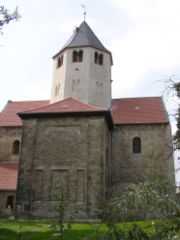Gröningen Priory

Gröningen Priory (Kloster Gröningen) was a house of the Benedictine Order located west of Gröningen in Saxony-Anhalt in Germany.
The monastery was founded in 936 from Corvey Abbey, of which it was a priory, on initiative of Saxon Count Siegfried of Merseburg and his second wife Guthia (Jutta) upon the death of King Henry I. It became part of the Bishopric of Halberstadt and was finally dissolved in 1550 in the course of the Protestant Reformation.
A building of particular interest is the monastery church of Saint Vitus, set on a slight eminence. It was dedicated in 940 by Abbot Flockmar (Volkmar) of Corvey and about 1200 re-built in the style of Hirsau Abbey as a Romanesque basilica with three aisles and a number of features of architectural interest. Of particular note is the very unusual octagonal crossing tower and the relief of Christ Pantocrator on a balustrade from the 12th century, a copy whose original is kept at the sculpture collection of the Bode Museum in Berlin.
See also
Coordinates: 51°56′14″N 11°11′49″E / 51.93722°N 11.19694°E